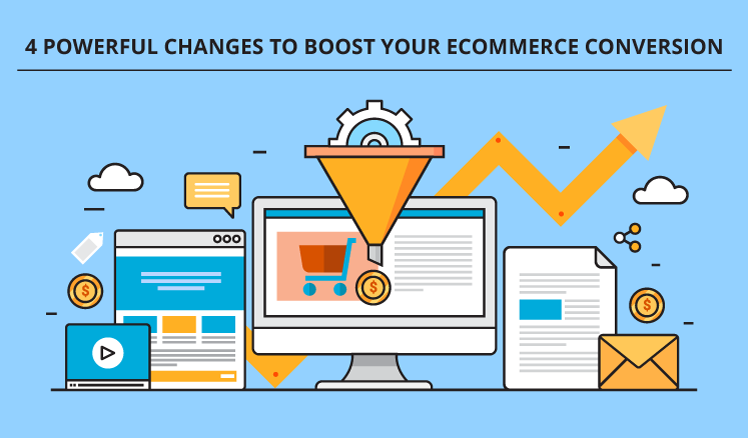4 powerful changes to boost your ecommerce conversion
The wonderful thing about ecommerce is that it’s so easy to get started in the industry – you just need an idea, an online store, and the will and skill to market it. But it’s much less wonderful if your conversions are low and your company finance director is sad.
Boosting conversions isn’t an art form or science – it’s about making plain, simple and strategic business decisions. Below, we have outlined how you can make the right choices for your ecommerce business, get your conversions on the up, and make you and your finance director happy.

1. Get the basics right
You’ve seen the traffic figures, and they’re great — you have enough people coming to your online store to fill the AT&T Stadium twice over. But your conversion rate doesn’t live up to those figures...not even close.
Luckily, improving this situation is not necessarily a long and drawn out process. Here are the top three ecommerce conversion killers — sort them out, and you will likely see a conversion uplift pretty soon.
1.1 Poor product photography and descriptions
Your visitors need to have faith in your brand, your business and, most importantly, the products you’re trying to sell them. If you’ve not put your heart and soul into your product descriptions and photography, they will feel it. The end result will be that they will not convert into customers and, instead, will go away to competitors. The action plan is:
- Audit and review your best and worst performing product pages.
- Elaborate detailed descriptions showing product features, the problems it solves and the benefits it offers.
- Provide high-quality product photography.
- Improve your value propositions and CTAs (calls-to-action).
- Learn from competitors.
1.2 Your online store isn’t mobile friendly
It’s no doubt that more and more people use mobile devices rather than a PC or a laptop to access the Internet. Having a responsive website isn’t just a must – avoiding it is tantamount to commerce suicide.
You can use Google’s free software to check if your site is optimized for mobile — you will get plenty of handy tips on what to fix for higher speed and better viewing experience for mobile users.
If your online store is still far from being mobile friendly, here are the rules you can start with to improve the situation:
- Stick to one-click ordering principle. The competitors are already doing it!
- Rigorously test your site on mobile.
- Make your website mobile responsive or create a mobile application with the help of professional ecommerce developers.
1.3 Poor website navigation
Visitors of your web store don’t know exactly what product they want to buy. Having opened a website with poorly designed navigation, they will hardly spend much time there and enjoy the shopping process. Quite the contrary, they are more likely to get disappointed. Here is what you can do about it:
- Sort products into intuitive categories. Craft category descriptions that entice.
- Use internal links in the form of banners, offers and breadcrumbs generously to help your clients find their way around the site.
- Link out to popular pages, products and categories in prominent places. It is probably what the user came for.
2. Invest in smart tools for conversion rate optimization
Selecting the right software is essential if you want to get the maximum conversion rate for your business on a reasonable budget.
2.1 Cart abandonment tools
More than 70% of shopping carts are abandoned. By investing in cart abandonment software, you can automatically retarget users who have left your store before making a purchase. Using retargeting tools has shown to increase the revenue by up to 50%.
2.2 Heatmaps
Heatmaps show you the pages where users are most active. You can then use this information to add a CTA there.
2.3 Exit intent marketing
Exit intent software follows a customer’s mouse movements and detects when they are about to leave. You can take action and entice them into staying and buying your products with popup ads for discounts and vouchers.
2.4 Customer re-engagement automation
Email marketing is still the strongest of channels, and you need an email automation tool to target your clients in a meaningful way and encourage their further interaction with your web store. Better isn’t always more expensive. Here is a review of 7 email marketing software tools that allow you to integrate with ecommerce and have a look inside with a free account before starting.
3. Employ analytics to target users who will most likely convert
There are a lot of ways to find the users that matter the most, but one is essential and trumps all others: make the most of your analytics. It allows you to:
- Trace the behavior of your clients
- See which regions your online store is most popular in
- Define the most valuable traffic sources
- Identify most visited, top landing and top abandoned pages
Leverage these insights to improve your web store and make it more appealing and intuitive for customers. Improved conversion is bound to follow.
For ecommerce, using analytical tools is the best way to succeed in any sort of paid advertising or media. Here is the action plan to make those campaigns work for you:
- Test relentlessly – review every element of your paid campaigns to define what resonates with customers.
- Get your landing pages right – make sure your landing pages have high-converting CTAs, attract with an eye-catching design and clearly sell the benefits of your products.
- Monitor and track every inbound sales channel – PPC allows you to add tracking codes. You can then target the channels with the highest conversion rates.
4. Develop a content marketing strategy around transparency
Content marketing is one of the best ways to raise awareness of your brand and increase transparency. Transparency inspires confidence in your brand, and more confident customers are more inclined to buy from your business.
There are three key criteria to use as the foundation for developing a content marketing strategy that increases brand transparency:
- You must be transparent about sourcing
- You must be transparent about pricing
- You must be transparent about experiences
One way to bring transparency to your content marketing is to add User Generated Reviews (UGC). Your clients really value the opinions of their fellow shoppers. Showing reviews on your online store can help build trust and increase your conversion rate.
Brand transparency can make a massive difference to your business – the results of a customer survey stated that 56% of people would become customers for life if a brand was completely transparent. That sort of loyalty will have a huge impact on your conversion rate.
Ecommerce has the potential for tremendous rewards. Follow the rules we outlined to fuel conversion, and the rewards will not be long in coming.


